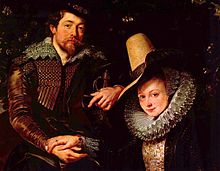Rubens and Isabella Brant in the honeysuckle arbor

|
| Rubens and Isabella Brant in the honeysuckle arbor |
|---|
| Peter Paul Rubens , around 1609 |
| Oil on canvas |
| 179 × 136.5 cm |
| Old Pinakothek |
The double portrait of Rubens and Isabella Brant in the honeysuckle arbor, or “The honeysuckle arbor” for short, is a Baroque oil painting by the Flemish painter Peter Paul Rubens , which was created around 1609 (probably before October 3rd). It depicts the artist and his then fiancée Isabella Brant (1591–1626) sitting close together in the open air as lovers . The 179 × 136.5 cm picture created near Antwerp is painted on canvas with oil and mounted on oak.
Rubens probably painted the picture as a wedding present for his mother-in-law, an Antwerp patrician. The wedding took place on October 3, 1609 in St. Michael's Church in Antwerp, Brant was Rubens' first wife.
The painting with the inventory no. 334 hangs in the Alte Pinakothek in Munich in the Rubenssaal (Hall VII) on the 1st floor as part of the permanent exhibition.
description
The full-length portrait shows the couple in loving togetherness with friendly and expressive faces. Their hands are touching. The interlocking of the two right hands ( dextrarum iunctio ) was already a sign of marriage in Roman times .
The artist, about 32 years old at the time of creation, presents himself as a diplomat , not as an artist. His gentleman sword , on whose basket the left hand rests, shows that he belongs to the nobility . The left elbow rests on a hidden ledge of the arbor construction. His right hand rests on the left thigh, the legs are crossed (the left on the right). On his left leg, his fiancée puts her hand on his. His left index finger discreetly indicates the hand that has been placed on it.
Isabella, around 18 years old, wears her full, precious dress with a gold and silver bodice, a millstone collar, a fashionable, high, delicate yellow shepherd's hat (Florentine hat) and a Dutch bonnet as a sign of marriage. She wears stone jewelry on both arms . She sits below Rubens, a good head height below. Both eyes are directed towards the viewer. Overall, the couple appear happy, confident and proud.
Another symbolism is the representation of the people under a honeysuckle plant (honeysuckle / Jelängerjelieber); this plant generally stands for loyalty , which is related to the upcoming wedding - thus the desired long-term marriage. Both people mostly wear dark clothing to make their faces stand out. The couple is shown in full format and life-size, with the couple forming an egg shape. Both persons are wearing hats and their gaze is fixed on the viewer. The small blue view of the landscape at the top left corresponds to the blue fabric at the bottom right.
Since the painter already enjoyed success and prosperity during his lifetime, he was able to afford assistants who were themselves respected and talented painters. This guaranteed him a high quality without having to waste his valuable time painting in colored areas. It can be assumed that large parts of this painting were also made by his helpers. The contrast in the execution of the painting style is particularly great in this picture. The inaccuracy of Rubens' stockings looks clumsy in contrast to the detail of the hair and facial features - almost as if these did not belong in the picture. It looks as if Rubens only painted the part of the picture that includes the heads and torso himself and left the rest to his helpers.
In the bourgeoisie, the portrait of a spouse was only common as a half -length portrait , more often as a diptych (two-part painted picture). Full or half-length portraits of couples were rare. It is one of numerous self-portraits of the painter, also of his second wife Hélène Fourment , from 1630 onwards he painted married portraits (as well as portraits). The work, which was created at an early high point in his work, is considered one of the most representative of European portrait art.
literature
- Julia Geiser: The honeysuckle arbor by Peter Paul Rubens , seminar paper, 14 p., 2004, Grin-Verlag, ISBN 3-638-54475-3
- Franz Roh: Die Geißblattlaube , in: Remigius Netzer (Hrsg.): Works of art of the world - experts interpret works from the public art possession , volume 1. Munich, Lambert Müller, 1961, p. 6 f. (without ISBN)
- Bauer, C. (2004), Peter Paul Rubens . Munich: Prestel.
Web links
Sources and footnotes
- ^ Rubens was a diplomat for the Spanish-Habsburg crown before his return to Antwerp


